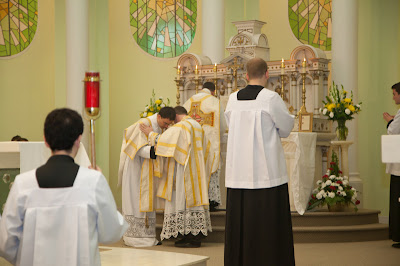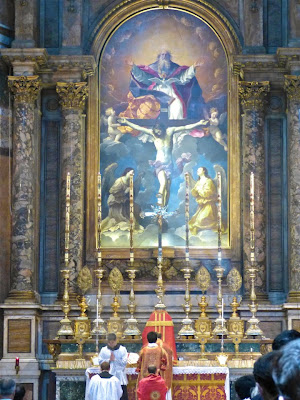![]()
I recently read Jean Corbon's book
The Wellspring of the Worship. In it Fr Corbon describes how an ordered participation in the liturgy opens our hearts in such a way that we accept God's love and enter into the mystery of the Trinity; in which we worship the Father, through the Son in the Spirit. This renews and transforms us so that we are rendered fruitful for God. The icon of the Transfiguration, he says, reminds us of this. It is an icon of the liturgy.
At one level the icon of the Transfiguration portrays, of course, the events as they happened in the bible. The composition of the icon shown above, by Theophanes the Greek, is ordered to Christ. He is flanked by the prophets Moses and Elijah who bow reverently. His appearance changes so that he and his clothing shine with uncreated light. Peter on the left is shown talking to Christ, he and the others all looking disoriented by what they are seeing and hearing. Three rays extend to the ears of the apostles as they hear the voice of the Father.
The biblical description of the Transfiguration, says Corbon, point not only to Christ's transfiguration but also to our own through participation in the liturgy. Through the liturgy, he says, the Church becomes the 'sacrament of communion between God and man' and as members of the mystical body of Christ we we partake of the divine nature becoming 'God as much as God becomes man' (quoting Maximus the Confessor). We participate in this glory. The disciples see Christ because they are raised up also in purity, symbolised by their going up the mountain. This enables them to see and to hear the divine light and voice. In this life we too by degrees, through our participation in the liturgy and participate in this glory and ascend the holy mountain. The complete transformation does not take place until the next life.
For Corbon, there is a threefold manifestation taking place here. First the revealing of Christ, second the purification of the hearts that enable us to see and grasp the truth; third and finally 'if we are given the gift of "believing in his name" and if we have received "power to become sons of God" (Jn 1:12), it is in order that he may send us into the world as he himself was sent by his Father. His Spirit gives us a new birth in order that his glory may be manifested to others through us and that they in turn may be transformed into the body of the Lord. This final extension of the life giving light is intended to communicate the reality that is the body of Christ and introduce into communion with it the scattered children of God.
This tells us how that in order to be agents of evangelisation, we must shine with the light of glory and it is through our ordered and active participation in the liturgy. 'If we consent in prayer to be flooded by the river of life, our entire being will be transformed: we will become trees of life and be increasingly able to produce the fruit of the Spirit : we will love with the very Love that is our God...This process is the drama of divinisation in which the mystery of the lived liturgy is brought to completion in each Christian'.
So do we really shine with light? I have never seen anyone shining like Christ as portrayed in these examples of the Transfiguration. If what Corbon says is true, one might at least expect to see a few halos or feint light of partial divinisation occasionally, if not a full-blown transfiguration. I fact, I feel I probably
have seen saintly people who are shining with light, but without knowing it. The fact that I do not see the light of glory in them is as much a reflection on me as the people I have met.
When I was learning to paint icons, my teacher who was an Orthodox monk told me a story that relates to this. I cannot remember the detail but the essence of it was this: two saints met and as they spoke to each other, each saw the other shining with halos of uncreated light. They were both amazed and later described what they had seen to a third party. On hearing the tale from each one, the third party realised what was happening, that each was a holy man, shining with the uncreated light but unaware of it. Because of their holiness and purity they were able to see the uncreated light of the other. The third person, who knew both, could not see the light in either.
If this is the extent of it, then it doesn't help us much, for only the holy, the already converted, are open to being conversion because they are the only ones who can see the light of glory. However, through God's grace there are other ways that we grasp with our inner eye of faith the glory that shines out of those we meet. In my own conversion there are a number of things that brought me to the Church. One was the beautiful liturgy of the Brompton Oratory. But it was also the examples of the people that I met who had an effect on me: their conduct, the glint in their eye, the sense of peace, the dignity and calm with which they went about their business. Although they didn't speak of their Catholicism much - just the occasional reference to it - I somehow knew that these qualities in them. This drew me to them and because I wanted these things too, to the Church which was the source. I always imagine that perhaps Christ's glory was shining through them, or some of them anyway. It was one of these people who, in a matter-of-fact way suggested that I might like to visit a church in South Kensignton one Sunday 'and if you do go, make sure you go to the eleven o'clock,' he said. I didn't even know that he was sending me to Catholic church, let alone Solemn Mass at the Oratory.
Corbon is telling me how I can be one of these people, an agent of transformation in the lives of others. Because society is the vector sum of personal relationships, this is the answer to the transformation of society as well. In the final slim but powerful chapter of the book he describes how this is the answer to the transformation of every aspect of the culture, including even economics and injustice in the workplace (I was amazed by this and wrote about it in my blog
here).
The images shown are the Transfiguration, first by Theophan (or Theophanes) the Greek, and Fra Angelico. Interestingly in this second image by the 15th century Dominican, St John is the one shown looking directly at Christ. One wonders if perhaps Fra Angelico is indicating that John has that purity of heart that enables him to look directly at the Lord. St Augustine tells us (cf Office of Readings, Saturday after Ascension) that the Church knows two lives: one is through faith, the other through vision; one is passed on pilgrimage in time, the other in our eternal home; one is life of action, the other of contemplation. The apostle Peter personifies the first life, John the second. Maybe this is what Fra Angelico is trying to communicate to us.
![]()
![]()
![]()
 The first is the fact that Rev. John Hunwicke, who will of course be familiar to many of our readers as the erudite and scholarly blogger at "Liturgical Notes", formerly of the Anglican communion and now part of the Ordinariate, is due to be ordained to the Catholic priesthood this Wednesday June 27, at 7.00pm in the Oxford Oratory.
The first is the fact that Rev. John Hunwicke, who will of course be familiar to many of our readers as the erudite and scholarly blogger at "Liturgical Notes", formerly of the Anglican communion and now part of the Ordinariate, is due to be ordained to the Catholic priesthood this Wednesday June 27, at 7.00pm in the Oxford Oratory. 















































































